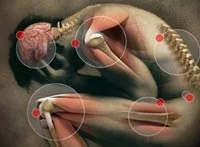Fibromyalgia Syndrome is also known as FM or FMS. Fibromyalgia is technically classified as a musculoskeletal disorder, but the condition is now 
The intensity of the usual fibromyalgia symptoms will differ from one individual to the next and might change based on other aspects, such as the time of day or the weather conditions. Because FMS is a persistent condition, the majority of fibromyalgia symptoms may never vanish unless treated.
Fibromyalgia clinical trials and research have shown that most victims display pain in certain areas. In contrast, others might experience total body discomfort, including pain in muscles and tendons, similar to some patients with multiple sclerosis.
Other symptoms of Fibromyalgia Include:
Stem cells are considered the building blocks of life due to their amazing creative potential and natural tendency to regenerate our bodies after injuries. They are essentially the body’s pharmacy.
In distress, our bodies release a naturally occurring protein called SDF-1. This protein guides the movement of other cells surrounding cells to begin homing and help begin the healing process. This “homing” function allows your body’s newly introduced stem cells to travel to the appropriate areas for repair duties. Autologous (From Your Body) or Allogeneic (HLA Matched and Donated) stem cells are typically isolated from peripheral blood, cord tissue, placental tissue, bone marrow, or adipose fat.[1]
The cells are then processed and expanded in our single system GMP-approved Class 5 Biomedical clean rooms where our microbiologists can prepare your therapeutic doses of stem cells.[2]
The prepared UC-MSC enriched stem cells and neurogenic growth factors are reinjected in multiple stages to promote rapid healing of the previously damaged cells.
The ability to extract and adequately expand/grow stem cells for an extended period is unique in our treatments. Expansion or lab-growing of stem cells is prohibited in some countries but essential when dealing with FMS symptoms.[3]
The total number of stem cell infusions for FMS and CF will vary based on the patient’s needs.
Types of Cells Used for in Fibromyalgia Treatment Protocol: Enriched UC-MSC+ Stem cells do not require any invasive surgeries to harvest seed cells, and the multi-stage cell infusions are usually made via intravenous Drips, Intrathecal delivery or fluoroscopic guided delivery (hospital setting) might be necessary in some cases to bypass the blood-brain barrier. [4]
Post-Treatment Rehab—Optional: Physical Rehabilitation is typically not required unless other underlying physical issues exist with the patients. However, we offer complete physical rehabilitation services post-therapy in Bangkok. Our rehab team can assist you upon request for 2-5 hours per day and up to 6 days per week. Medical travel visa assistance and extended accommodations at a hotel or apartment for the patient and family can also be provided upon request.
Our multi-stage treatment for Fibromyalgia with Stem Cells will require 10-14 days in Bangkok, depending on the patient’s needs. Due to the varying degrees, areas, and sources of injuries, our rheumatologist and medical team will need to understand a potential patient better before acceptance. Upon completion of the evaluation, a detailed treatment plan will be provided, including specific medical recommendations, a day-by-day calendar with stages, the exact total number of nights required, and the total medical-related costs (excluding accommodations or flights). To begin the qualification process for our multi-stage treatment protocol, please prepare your recent medical records, such as blood and urine tests, and contact us today.
[1] ^ Yeephu, Suwimon, Chuthamanee Suthisisang, Saithip Suttiruksa, Pradit Prateepavanich, Patchara Limampai, and Irwin Jon Russell. 2013. Efficacy and safety of mirtazapine in fibromyalgia syndrome patients: a randomized placebo-controlled pilot study in Thailand. The Annals of pharmacotherapy, no. 7-8 (June 4). doi:10.1345/aph.1R725. https://www.ncbi.nlm.nih.gov/pubmed/23737510
[2] ^ Gunduz, B, Y A Bayazit, F Celenk, C Saridoğan, A G Guclu, E Orcan, and J Meray. 2008. Absence of contralateral suppression of transiently evoked otoacoustic emissions in fibromyalgia syndrome. The Journal of laryngology and otology, no. 10 (March 4). doi:10.1017/S0022215107001569. https://www.ncbi.nlm.nih.gov/pubmed/18318918
[3] ^ Busse, Jason W, Shanil Ebrahim, Gaelan Connell, Eric A Coomes, Paul Bruno, Keshena Malik, David Torrance, et al. 2013. Systematic review and network meta-analysis of interventions for fibromyalgia: a protocol. Systematic reviews (March 13). doi:10.1186/2046-4053-2-18. https://www.ncbi.nlm.nih.gov/pubmed/23497523
[4] ^ Üçeyler, Nurcan, Daniel Zeller, Ann-Kathrin Kahn, Susanne Kewenig, Sarah Kittel-Schneider, Annina Schmid, Jordi Casanova-Molla, Karlheinz Reiners, and Claudia Sommer. 2013. Small fibre pathology in patients with fibromyalgia syndrome. Brain : a journal of neurology, no. Pt 6 (March 9). doi:10.1093/brain/awt053. https://www.ncbi.nlm.nih.gov/pubmed/23474848